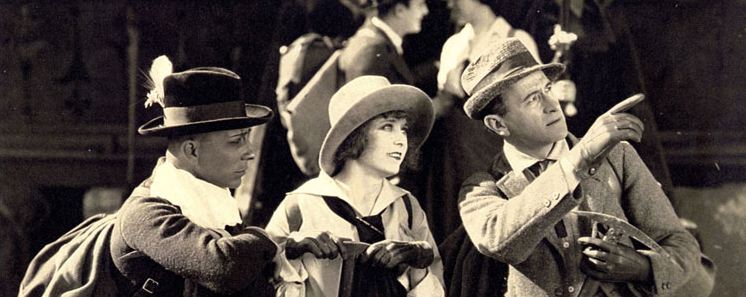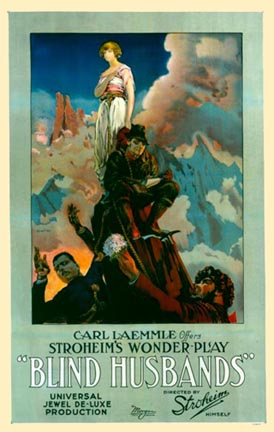
Blind
Husbands (from 1919) remains the most astonishing directorial debut in
the history of American movies. The film has been compared to Citizen
Kane in that regard, but it has also been pointed out that Welles's
startling debut was preceded by a significant body of work in theater
and radio which brought him serious critical acclaim as well as
national prominence, and made the phenomenon of Kane less surprising.
Erich
Von Stroheim had worked as an assistant in various capacities on the
Griffith lot and for director John Emerson, and he'd made a name for
himself as a character actor doing variations on his trademark wicked
Hun impersonation. He had, in fact, more practical experience of
filmmaking than Welles did before he made Kane — but there was
nothing in his resume which could have prepared anyone for the mastery
of the medium, the creative brilliance, on display in Blind Husbands.
In this
film he managed to refine the documentary power of Griffith at his best
and combine it with an expressionistic visual poetry worthy of Murnau.
It has the feel of a work conceived for its medium alone, with no
echoes of stage practice — not surprising since Von Stroheim had no
significant stage experience himself. (He had written one unproduced
play.)
In his
biography of the director, Richard Koszarski points out that Von
Stroheim saw the importance of Griffith's obsessive concern with detail
and authenticity in costumes and settings — this was a key way of
enthralling an audience and trumping stage practice, no matter how
elaborate. Yet because Griffith usually looked to the melodramatic stage
for his narratives and only occasionally explored interiors in purely
cinematic ways, an aesthetic tension remained in his work — he always
seemed to have a foot in both worlds, that of the stage and that of the
cinema.
The tension is dissolved in Blind Husbands. There is no sense, in either interiors or exteriors, of the theatrical
“set”. The camera seems to be exploring real places — however idealized or fantastical.
Much
has been made of Von Stroheim's obsession with seemingly insignificant
details, as though it represented some kind of pathology, but this was
crucial to his method — to get actors to behave as though they were
inhabiting real places, to convince audiences that they were watching
(and vicariously inhabiting) real places.
Audiences
and critics of the time recognized the power of this approach, even if
they didn't always appreciate how it was achieved — how it moved
cinema one step further from the Victorian stage. Griffith could throw
Lillian Gish out onto a real piece of ice on a frozen river, and in the
same film shoot and stage an interior as though it were being enacted
within a proscenium arch. It was the totality and integrity of Von
Stroheim's realized vision of a cinematic universe that made Blind
Husbands an immediate sensation.
The
film cost a bit more than $100,000, and Universal spent slightly
more than that promoting it — but it brought in over $300,000
during its first year of release, at a time when the average Universal
film was bringing in just over $50,000.
Making
a film like Blind Husbands was obviously riskier than churning out
programmers, but it represented a formula for commercial success all
the same — and one curiously similar to the blockbuster event-film
formula currently followed in Hollywood. Today the money is most often spent on
special effects — but in Von Stroheim's day, his obsessive recreations
and presentations of reality must have struck audiences as very special
effects indeed, and every bit as thrilling, as cutting-edge, as
exploding Death Stars.
It should be added that Von Stroheim's method is still thrilling, some 85 years on, in a way the startling digital effects
of our time may not be in a few generations.
The
film tries for a greater psychological complexity than conventional
melodrama, and presents adulterous temptation with an erotic frankness
unusual in its time, but it is still a rather ordinary love triangle at
heart. It's the organic integration of the physical world into its
drama and the power and beauty of its images which make it magical and
memorable — a purely cinematic masterpiece.
(All
versions of the film available today derive from a cut-down re-release
from 1924. About twenty minutes were removed, and the clumsy pacing and
hurried feel of so many sequences in this version suggest that much of
the cutting simply involved the trimming of individual shots. One can
only imagine the power of the film if its images could be relished at a
more leisurely pace.)

